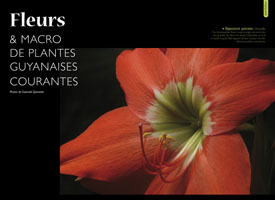The wealth of plant life in French Guiana leads a certain number of new arrivals to become interested in botany. The fascinating and majestic trees arouse people’s curiosity and are a common subject of interest. Many people dream of knowing about the trees of French Guiana and being able to identify them, but without perhaps realising quite how ambitious and difficult a task this is.
How can one set about identifying species when the most useful criteria for identifying plants – the leaves, flowers, fruits – are often several tens of metres above the ground, out of reach and often out of sight? Even when, on occasion, they are lying in plenty on the ground, it is not always easy to say which tree they have fallen from. So under these conditions, unless you have specialist instruments, you have to do to make do with the most readily available characteristics (bark, colour of the sap, and what you can see if you cut a notch) and the shallow roots (stilt and creeping roots). It is true that these can give you precious information, but with which it is unrealistic to try to identify a tree from over 1000 species.
So it can rapidly become a thankless and frustrating activity. Far from seeking to discourage people in this task, it can be useful to remind them that there are a very large number of more modest plants in the local flora to be found in the undergrowth, on roadside verges, and even in towns, and that it is easy to overlook them or even trample them underfoot. But seeking to identify these forgotten plants brings its share of surprises and wonder for anyone prepared to take the time to look closely at them, and the resultant pleasure is often inversely proportional to the size of the object studied. Perhaps these photos will champion the cause for a few of these plants to which we scarcely even give a second look.




 English
English Français
Français  Português
Português 


 Pas de réaction
Pas de réaction Comment!
Comment!



 Voyages avec Tooy. Histoire, mémoire, imaginaire des Amériques noires : Editions Vents d’ailleurs, 2010
Voyages avec Tooy. Histoire, mémoire, imaginaire des Amériques noires : Editions Vents d’ailleurs, 2010
 Guyane. Produits du terroir et recettes traditionnelles. L’inventaire du patrimoine culinaire de la France : Editions Albin Michel, 1999
Guyane. Produits du terroir et recettes traditionnelles. L’inventaire du patrimoine culinaire de la France : Editions Albin Michel, 1999
 Alunawalé, un voyage à travers les milieux naturels de Guyane : Office National des Forêts, 2009
Alunawalé, un voyage à travers les milieux naturels de Guyane : Office National des Forêts, 2009
 Augusta Curiel, Fotografe in Suiriname 1904 – 1937 : Libri Misei Surinamensis, 2007
Augusta Curiel, Fotografe in Suiriname 1904 – 1937 : Libri Misei Surinamensis, 2007

